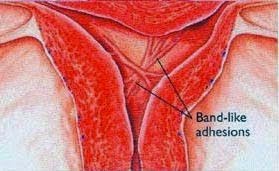Asherman′s Syndrome: Diagnosis & Treatment
Asherman′s Syndrome: Diagnosis & Treatment

Asherman’s Syndrome is a condition characterized by adhesions and/or scaring of the endometrium most often develop after uterine surgery and also most often associated with women who had undergone several Dilation and Curettage (D&C) of the intrauterine cavity.
Diagnosis
The history of a surgery or pregnancy event followed by a D&C, leading to secondary amenorrhea or hypomenorrhea is typical. Hysteroscopy is the gold standard for diagnosis. During hysteroscopy, a small camera is inserted through the cervix that allows doctor to look at the inside of the uterus under magnification. These tests may reveal scar tissue partially or completely filling the uterine cavity. Imaging by sonohysterography or hysterosalpingography will reveal the extent of the scar formation. Ultrasound is not a reliable method of diagnosing Asherman’s Syndrome.
Treatment
Treatment of Asherman’s syndrome is usually surgical, blind procedure is not advised as this often leads to further complications. Surgical treatment includes cutting and removing adhesions or scar tissue within the uterine cavity. This can usually be performed under direct vision with the aid of hysteroscopy – small instruments and a camera are placed into the uterus through the cervix.
After scar tissue is removed, the uterine cavity must be kept open while it heals to prevent recurrence of the adhesions, as Intra Uterine Adhesions frequently reform after surgery; techniques have been developed to prevent recurrence of adhesions. Methods to prevent adhesion reformation include the use of mechanical barriers, a small balloon or Intrauterine device is placed inside the uterus for several days or months and estrogen may be prescribed as replacement therapy for several months while the uterine lining heals.



